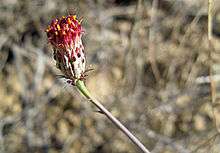Adenophyllum porophylloides
| Adenophyllum porophylloides | |
|---|---|
 | |
| Scientific classification | |
| Kingdom: | Plantae |
| (unranked): | Angiosperms |
| (unranked): | Eudicots |
| (unranked): | Asterids |
| Order: | Asterales |
| Family: | Asteraceae |
| Tribe: | Tageteae |
| Genus: | Adenophyllum |
| Species: | A. porophylloides |
| Binomial name | |
| Adenophyllum porophylloides (A.Gray) Strother | |
| Synonyms[1] | |
| |
Adenophyllum porophylloides is a species of flowering plant in the daisy family known by the common names San Felipe dogweed and San Felipe dyssodia. It is native to the Sonoran and Mojave Deserts of the southwestern United States (Arizona, California, Nevada) and northwestern Mexico (Sonora, Baja California, Baja California Sur).[2][3][4][5]
Adenophyllum porophylloides is an aromatic desert subshrub with several branching stems reaching a maximum height near 60 centimeters. The sparse, clawlike leaves are divided into sharply pointed linear lobes that bear prominent resin glands. The foliage has an unpleasant scent. The inflorescence is borne on a peduncle several centimeters long. The flower head is cylindrical and lined with phyllaries with large resin glands on them. The tip of the head blooms with bright yellow to reddish orange disc florets. There are sometimes short, stubby yellow to reddish ray florets along the rim. The fruit is an achene about 5 millimeters long with a bristly, scaly pappus.[2][6]
References
- ↑ The Plant List, Adenophyllum porophylloides (A.Gray) Strother
- 1 2 Flora of North America Vol. 21 Page 238, 239 Adenophyllum porophylloides (A. Gray) Strother, Sida. 11: 377. 1986.
- ↑ Biota of North America Program 2014 county distribution map
- ↑ Calflora taxon report, Adenophyllum porophylloides (A. Gray) Strother San Felipe dogweed, San felipe dyssodia
- ↑ Turner, B. L. 1996. The Comps of Mexico: A systematic account of the family Asteraceae, vol. 6. Tageteae and Athemideae. Phytologia Memoirs 10: i–ii, 1–22, 43–93.
- ↑ Jepson Manual Treatment
External links
- United States Department of Agriculture Plants Profile
- Calphotos Photo gallery, University of California @ Berkeley